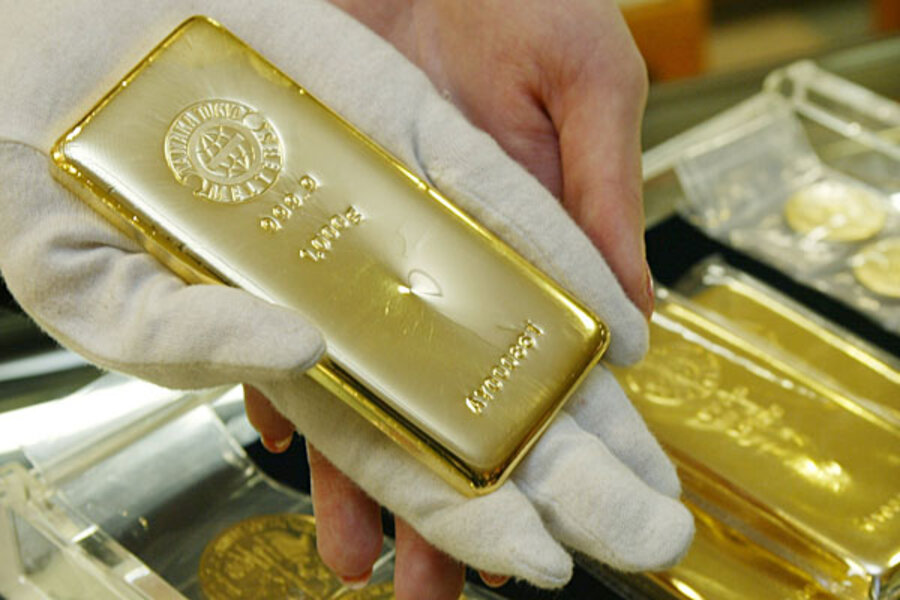Gold rush? Why gold standard glitters for some in GOP.
Loading...
Interrupting “Bonanza,” one of the most popular TV shows in the nation, President Richard Nixon in 1971 told the country he was “temporarily” ending the link between gold and the US dollar.
Since then the value of the dollar has “floated,” depending on the state of the economy and Federal Reserve policy.
Now, at least two out of seven major Republican candidates have said they support returning to a “gold standard” which would require the US to backup every dollar with gold stored in Fort Knox or the New York Federal Reserve.
Backers of a gold standard – a view popular with many tea party advocates – see a gold-backed currency as a way to rein in government spending and minimize the role of the Federal Reserve. Traditional economists consider the concept a bad idea, arguing it would hamstring the ability of policymakers to respond to changing economic times.
The most vocal pro-gold-standard candidate is Ron Paul, now running third in Iowa polls. It is one of his signature issues. “We need honest money, a gold standard and not paper money out of the Federal Reserve system,” said Mr. Paul at a debate in Ames, Iowa in August.
Newt Gingrich, running second in Iowa, says he is in favor of “hard money with a very limited Federal Reserve.” He also said he favors a dollar that is “good as gold.”
One of the most vocal advocates of returning to the gold standard is Jeff Bell, the policy director of American Principles in Action, which recently sponsored a forum for Republican candidates in South Carolina.
Mr. Bell argues that gold should be the final currency of the world, instead of the dollar. He thinks any American should be able to go to a bank and convert his or her money into a gold ingot or two. The actual amount a person would receive would depend on the market. “Say you have thirty months of market activity, then the secretary of the Treasury locks in a value for the price of gold based on that activity,” he says. “That would give you a good approximation of how many dollars would be represented by an ounce of gold.”
Advocates for gold argue that policymakers can’t be trusted to run the economy. In theory, using gold limits the amount of money the Federal Reserve can print, which might prevent inflation from decimating the value of the currency.
“The market would control the money supply, not some PhD from MIT,” says Bell.
Of course there was a time when the US government did offer its citizens a chance to exchange their cash for gold or silver. Between 1816 to 1914, a gold standard existed with most nations linked to a specific gold price. As World War I began, the system ended.
After World War II, world leaders adopted a modified form of the gold standard, known as the Bretton Woods Agreement. Each nation’s currency was linked to the US dollar (fixed exchange rates) which was in turn linked to gold priced at $35 an ounce. But Americans no longer could exchange money for gold. The linkage was reserved for central banks.
That system was in place until Mr. Nixon closed the gold window that Sunday night in 1971, interrupting the adventures of the Cartwright family on the Ponderosa ranch.
Mainstream economists argue going back to convertibility of the greenback into gold or silver is a bad idea.
“Most economists agree that a money supply needs to be flexible, able to change with economic conditions,” says Richard DeKaser, chief economist at the Parthenon Group, a business consulting firm, in Boston, Mass. “There are times when credit needs are greater.”
Mr. DeKaser points out that central banks were formed because farmers had a greater need for funding at certain times of the year. If the money supply were fixed by the amount of gold on hand, this could limit lending, he argues.
Lyle Gramley, a former member of the Federal Reserve’s Board of Governors, calls the concept “the stupidest idea I can think of.”
Mr. Gramley can understand the distrust of politicians. He says one of the reasons why Nixon unlinked the US from gold was because he was unhappy over the pace of the economic recovery from the recession in 1970. “He was concerned that somehow the quantity of gold we held would reduce the Fed’s ability to increase the money supply and therefore ensure his election.”
But Gramley says he thinks the distrust of central bankers is misplaced. He maintains central bankers for the past twenty-five years have been generally successful at scotching inflation fires. On Friday, for example, the government reported the inflation rate as measured by the Consumer Price Index was zero percent for November.
Bell, however, doesn’t buy that argument. Even though the government reports inflation at a low rate, he argues the price of food and gasoline have risen much faster than the government inflation statistics. “The truth is we have more inflation than most times since the 1970s,” he says. “Ben Bernanke [Fed Chairman] has the worst record on inflation of any Fed Chairman since Arthur Burns [Fed Chairman from 197-1978].”
However, DeKaser says gold has also caused its share of inflation. “When we used to have major gold finds – think of the California gold rush – then we had surges in inflation,” he says.





